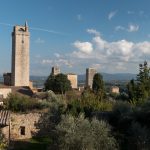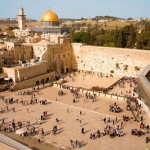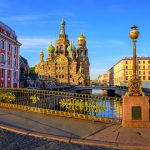
We began exploring in Marseille by climbing to the highest point in the city to Notre Dame de la Garde Basilica. The views of Marseille, its old port and the sea beyond were stunning from our vantage point, situated more than 500 feet above sea level. If for no other reason, the photographs alone make a visit to Notre Dame de la Garde worthwhile.

We spent nearly half an hour outside simply to admire the views and to snap photographs before heading into the basilica. It was a gorgeous day in Marseille, even though rain threatened, and it felt good to be soaking up the atmosphere of this beautiful region in the south of France.
The basilica, we learned, was built on the site of an ancient fortress. We stepped through the doors of the basilica into an interior that was largely Byzantine. I was intrigued by a number of small, toy-like wooden boats hanging from the ceiling. Clearly, Marseille has a close connection with the sea and with sailing.

We left the basilica for a drive along the Corniche du Président John Fitzgerald Kennedy, a beautiful stretch of highway along the coastline. Our drive rewarded us with views of the Mediterranean Sea, the Iles du Frioul (islands), 19th century villas and the Prado Beaches. After perhaps 15 minutes, the highway brought us to Marseille’s Vieux Port (Old Port), which was bustling with activity.

The harbor, in fact, has been busy with activity for centuries, ever since the Greeks first landed here in 600 BC. Tens of thousands of merchant ships used to sail into and out of the harbor, and it was an important center of commerce for Marseille and the rest of France. Today, the harbor is filled with small fishing boats and sailboats, and the Old Port is busy with tourists and locals who come to shop or dine.

We sat down at a small seaside café along the southern quai de Rive Neuve for moules frites, the famed dish of mussels and french fries that are so popular in France. The mussels were exquisite, served in a large pot, along with a basket of fries on the side. We washed it all down with a glass of Rosé — from Provence, of course.

Our next stop was Aix-En-Provence. We traveled a highway that took us though the Provençal countryside into the charming old town, where we strolled the Grand Cours Mirabeau, a wide avenue built on the site of the city’s medieval ramparts and shaded by rows of 200-year-old plane trees, known as sycamores in North America.

The ‘Cours,’ as it is called by locals, is flanked by cafés, shops and the elegant façades of gracious 17th- and 18th-century mansions. We spent time admiring and photographing the mansions’ wrought-iron balconies and finely carved doorways.
At one end of the Cours is a large fountain known as the Rotonde, which is the centerpiece of a roundabout in the heart of the old town.

Of the many cafés along the Cours, one of the most famous is Les Deux Garçons, which was once frequented by famous French cultural figures such as Paul Cézanne, Émile Zola and Albert Camus.

Cézanne once lived in the old Mazarin District, only a few blocks away from the Cours. On our way to the neighborhood where the artist lived, we paused at Place Des Quatre Dauphins to photograph a well known fountain of four dolphins, an example of the Baroque art so prized by the Aixoise nobility.
It is fascinating to meander along the small inner streets of Aix admiring the city’s Roman architecture, its elegant fountains, the charming boutique shops and beautiful markets. As an added bonus, the scent of lavender seemed to greet us at every turn. Aix smells as good as it looks.

We strolled the old town to Place d’Albertas, distinguished by shuttered mansions enclosing a cobble-stoned square with a fountain at its center. From there, we walked past Hôtel de Ville (City Hall) on our way to Saint Sauveur Cathedral (Aix Cathedral). Constructed on the site of an ancient Roman forum, the cathedral is notable for its contrasting architectural styles, including Romanesque, Gothic and neo-Gothic, a legacy of countless additions and renovations performed between the 5th and 18th centuries. We admired the remnants of a Roman-era wall and the 15th century Gothic portal.

We left Aix-en-Provence to make our way to Avignon, beautifully situated along the Rhône River and punctuated by UNESCO World Heritage Sites. We walked through the medieval old city to visit the Palais des Papes, or the Popes’ Palace. I was surprised to learn that in the 14th century the seat of Catholicism was not in Rome but here in Avignon, where a succession of nine popes reigned from 1307-1376.

One of the largest and most important medieval Gothic buildings in Europe, the Pope’s Palace features chapels, gardens and frescoes. You could spend hours exploring all of it. We combined our visit with a walk out onto the famous Pont Saint-Bénézet also known as the Pont d’Avignon. Built between 1177 and 1185, the medieval bridge spans the Rhône River — almost

The early bridge was destroyed during the Albigensian Crusade when Louis VIII of France laid siege to Avignon. The bridge was rebuilt with stone arches, but the arches tended to collapse when the Rhône flooded. Too costly to repair, the bridge remains an Avignon landmark and the inspiration for Sur le Pont d’Avignon, a French song that dates back to the 15th century. The surviving arches that still support the bridge now comprise a UNESCO World Heritage Site, along with Avignon’s Palais des Papes and Cathédrale Notre-Dame des Doms.

Famished from our morning and partial afternoon of sight-seeing, we sat down for a three-course lunch at the Auberge de la Treille, a gorgeous mansion and restaurant along the banks of the Rhône. The setting was remarkable, quintessentially French. We dined in a earthen courtyard, shaded by plane trees, with elegant tables set upon the dirt. The food was exquisite, including the delicious cheese plate served at the end of the meal.

The popes who came to Avignon knew about the wines being produced in nearby Chateauneuf, a beautiful village just 20 minutes or so from Avignon on the Rhône River. They began to produce their own wines here, giving birth to the internationally acclaimed Chateauneuf du Pape. We owe them a bit of gratitude. I sipped one of the best red wines I have ever tasted at Skalli Pavilion, a winery that poured me a glass of Maison Bouachon Chateauneuf-du-Pape Dedication. It was the perfect way to cap a perfect day in Avignon.

As we discovered during our three days exploring the region, Marseille offers cruise passengers quite a lot of variety — from UNESCO World Heritage Sites in Avignon to Provençal charm in Aix-en-Provence to world-renown wines in Chateauneuf du Pape. Plus, there’s Marseille itself, with its bustling city center and historic sites, all nestled around the city’s intriguing Old Port.



